(Editor’s Note: This is the third and final instalment of Siebert’s recent journey to three Wilderness camps in Botswana. Read parts one and two, featuring Savuti here and DumaTau here.)
FRIDAY, 10 JUNE – DAY FIVE
The lesson in northern Botswana’s mysterious faultlines and water flows stuck: those evenings at DumaTau, out on the Zibadianja Lagoon at sunset with uber-informative guide See Oja, aren’t easily forgotten. I’m flying again, in another Wilderness Air Cessna Grand Caravan, leaving the Linyanti and heading for the Okavango. Water, water, everywhere below. I spot a familiar fluid outline off to the west, and ask the pilot: ‘That’s the Selinda Spillway, right?’ It is. See taught me well.

My next destination is one of Wilderness’ most beloved camps, recently revamped: Vumbura Plains, in the far north of the Delta. I’ve been to the Delta before, but roughing it – camping out on various palm-studded islands, trying to avoid the hippo and elephant paths. From what I’ve heard of the ‘new’ Vumbura, it is countless elevations above camping.

We land smoothly, and disembark onto the runway. Bright winter sunshine pours down. Wilderness game vehicles line up to receive us, as do their drivers – the guides who make the Wilderness experience so exceptional. So far on this week’s journey I’ve had two remarkable guides – See at DumaTau and Keith at Savuti – so I’m hoping for a trifecta of guide good luck.
Jakoba Mandela, aviators flashing, strolls up to introduce himself: my Vumbura guide. I ask – he’s no relation to Nelson. He’s 32, generally called ‘Jakes’, from the village of Luzwe in southwest Botswana, and part Bushman. He’s the epitome of cool.
Minutes out of the airstrip we pass a herd of red lechwe, abundant in these parts, and Jakes starts guiding.
‘This place is dominated by seasonal floodplains, also permanent swamps, mopane woodlands, and riverine forests. The floods started in May…around September-October this area will be completely dry. The rains will start again in November’. Again, the subject is water, the cycle of rain, weather. ‘If the flood is huge, the airstrip will be completely under water’.
Even in the dry season you can do boating and mokoro (traditional dugout canoe) trips, Jakes says. And game viewing is sensational year round.

The landscape is more open than the Linyanti, where I’ve spent the last four days. The same giant trees, though, more of my favourite majestic jackalberries. We pass baboons, and a sausage tree with dangling ‘sausages’; I imagine being knocked out by one.
‘We don’t have a lion pride now…’ Jakes resumes. ‘The special animal you might get to see is sable’ – the stunning rare antelope. (Sadly, we never do.)
I ask about possibly visiting one of the five villages of the Okavango Community Trust, Wilderness’ local community partner. The water’s too high now to drive there, Jakes says, and there’s scarce chance of hijacking the company helicopter. But he tells me about some of the local community impact.
‘We’ve done a lot in this concession’, he says. ‘Cluster farming, for instance, for the five villages of the Trust. Wilderness sent tractors to plough all the farmers’ fields and they sell their produce – sorghum, millet, maize, morogo, etc. – back to Wilderness at a higher than market price. Eighty percent of Vumbura’s staff is from those five villages’.

He’s been with Wilderness for eight years, and praises its training programmes and investment in the people who work there. ‘At Wilderness, you don’t come and stay a waiter forever. You ascend’.
Passing several small elephant herds, we talk about the work that Maun-based NGO Ecoexist does locally to mitigate human-wildlife conflict, in partnership with Wilderness and others. The Trust villages sit on or near elephant corridors – migratory routes – so collaring them helps monitor their paths and redirect them where necessary, reducing confrontations between them and local farmers. Both humans and elephants win.
We come upon a seasonal lagoon, glinting in the strong afternoon light. ‘You know what will happen here when the water recedes in August-September?’ Jakes asks. ‘All the fish will be trapped, and all these birds – marabou storks, saddle-billed storks, wattled cranes, pelicans, and more – will come eat them’. Not a pretty picture, I’d imagine, but a fascinating feeding frenzy and birding extravaganza.
Vumbura finally appears, snuggled into the bush, with another warm welcome – this time led by Nadia, sommelier extraordinaire I soon discover. I detect a Cape accent; sure enough, she used to live in Cape Town. I follow her energy into the airy, open lounge and bar area, drenched in blues, greens, and purples, the Delta’s colours, with the vast floodplains stretching infinitely beyond. My senses are overwhelmed: hippos snorting, everything awash with colour, including dozens of handwoven baskets on the lounge shelves, and outside on a lengthy deck small tables set with shapely glass vases, more blue/green/purple, refracting the light.

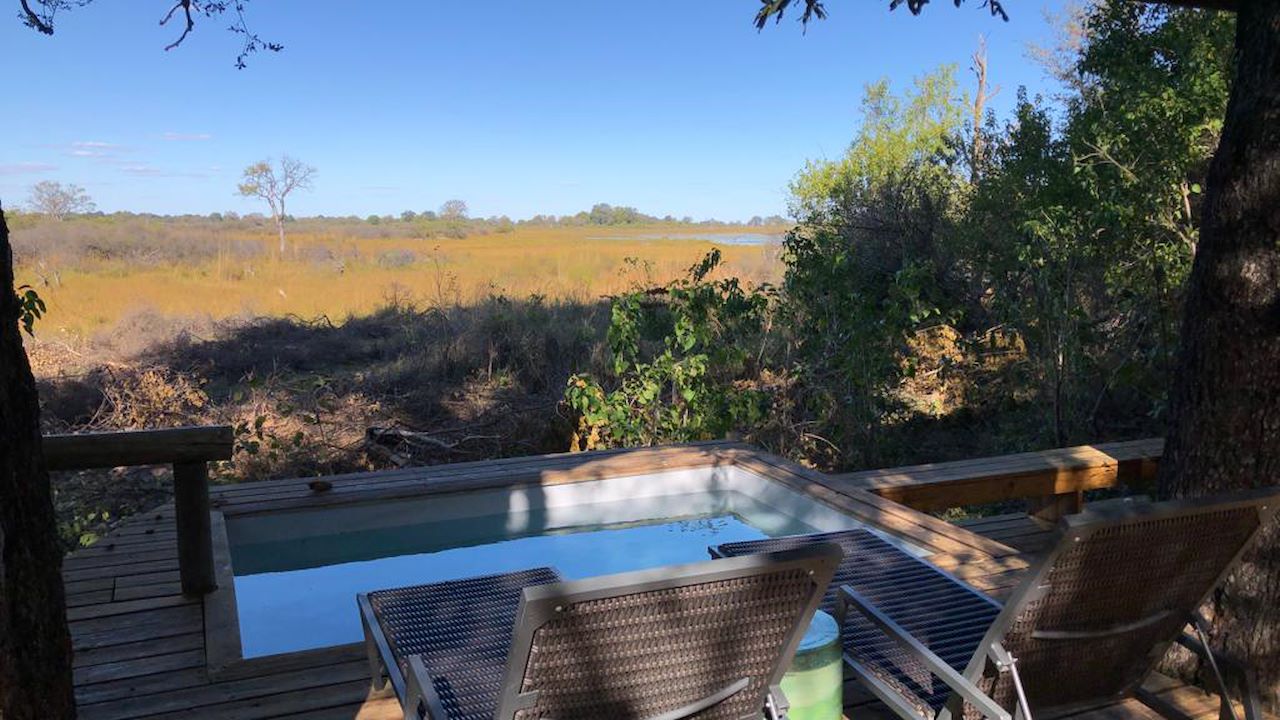



Nadia leads me down the long boardwalk to my room – pointing out the creature crossing spots where the boardwalk intermittently descends. I’m in Suite 1, the furthest from the common areas, and once we pass through the door of the high wooden enclosure, the magic hits: a huge outside area with day bed and loungers, plunge pool, and of course, two giant jackalberries, framing the floodplain beyond. Inside is phenomenal, spacious and drawing me into the environment. I’m inside but would hardly know it, with the walls mostly invisible mesh, the colours again reflecting the exterior waterscapes. I’m not sure I’ll ever leave my room. In fact I don’t, other than for a convivial supper with relief manager Sasha, by lamplight on the deck – then back for sweet, sonorous dreams.
SATURDAY, 11 JUNE

Up at dawn; the sunrise over the floodplains enchants. Jakes and I depart for a short game drive en route to the boat station, from where we’ll travel to Vumbura’s smaller sister camp, Little Vumbura – one of Wilderness’ most popular destinations. We slide across the sands in the game vehicle; this is the Kalahari Desert, I remember.
I also remember what Jakes said yesterday, about the lions, and ask for elaboration.
‘There are no actual lion prides here at the moment’, he says. ‘Because of males coming into the area in 2019 and killing cubs. We lost a lot of data on the lions due to COVID, when the camp was closed.
‘But we know that now there are 13 male lions in a 20 square kilometre space….We’re not sure how many females are around. Most have dispersed because of the males fighting and killing cubs’.
Speak of the devil. Fellow guides radio that two of these infamous males – perhaps the most infamous, defending their turf fiercely – are on the move nearby. The Eastern Boys, Jakes says. The baddest boys around.
We catch up to two other game vehicles tracking the lions. The bush is thick, but then I spot a black-tipped tail, and excitedly tell Jakes. Who quips, ‘Only a tail, no lion?’

Not just one lion, a pair. The larger, with a thick, black-tinged mane, almost like those found in the Kalahari (wait, this IS the Kalahari under our feet, right?), his mate not quite as huge or impressive. They’re patrolling, side by side, intimidating. Finally they move out into the open, and Jakes agreeably swings the game vehicle around so I can look straight into the big guy’s piercing amber eyes.
I could watch them for hours, but it’s time to get to the water, so we veer off, arriving shortly at a small dock where several Delta boats are tethered. Jakes unties one and soon we’re swerving around the channels, red lechwe leaping, my heart in my throat, but I like the rush. Twenty minutes or so and we reach Little Vumbura’s small island; camp manager Faith waves and dances from the dock.

The visit to this charming, intimate tented camp – wide open to nature, so tastefully, minimally adorned – flips by in a blur; we don’t have much time. Faith gives me a short tour; I vow to return. Apparently wildlife – elephant and hippo included – comes and goes as it pleases, but today we spot only two lechwe chilling on a small beach.
Back at Vumbura, I chat for an hour or so to four women who work in housekeeping there, but also make the beautiful baskets on display, for sale. It’s an art; each pattern has a meaning, the dyes are sourced from trees, mainly. An art passed down from mother to daughter. I buy two, but could have bought twenty.
Late afternoon comes, along with my scheduled mokoro excursion. Jakes is driving to the departure point; guide/poler Max and I sit in the back. I grill him en route about mokoro poling – another fine art.

I learn this: Max has been poling for 28 years, from age 10, taught by his grandfather; it took him three years to get his poling licence; traditional wooden mekoro were replaced by fibreglass ones about 25 years ago, to save the forests; mekoro are still used in daily life in the Delta.
Perhaps most interesting, shares Max: ‘Traditionally, to prove your manhood you had to build a house…and a mokoro’.
At the departure point other guests are climbing into the canoes – which look like wood – being steadied by their polers. I climb into ours, Max at the back of course, standing upright and clutching a thin 2.5-metre pole. An Okavango gondolier. He shoves us off and soon we glide into a thicket of golden-green reeds – where I’m eye-to-eye with a tiny, motionless Angolan reed frog.

‘Light brown with darker brown spots…it’s a she’, Max says. ‘These frogs feed on mosquitos and flies…so they help control malaria…(pause)…She’s waiting till it gets dark to call, so she doesn’t call attention to herself, to birds like coucals and herons. She’s perched up high so pike and tiger fish can’t reach her’.
More frog info: ‘Females only mate with males with a good voice’, Max says. ‘If a male doesn’t have a good voice, he’ll perch next to one with a good voice, closer to the female so that she will mate with him first’. Clever boy.
As the sun begins to set, and we drift through the reeds to the rising chorus of frogs and call of a grey go-away bird, Max talks about other creatures around. Spiders, other frogs, otters, terrapins, snakes. Glad we’re not spotting a python. A lone hippo grunts not far off. Max’s interpretation: ‘He’s laughing at us’.

The sky turns into streaks of deep blue and purple, the polers’ silhouettes striking on the horizon. We head towards shore, where awaits a ‘wow’ surprise: sundowners and snacks illuminated by swaying lanterns. The wine is welcome, but I want to stay on the water, singing with the frogs.
SUNDAY, 12 JUNE
Hard to believe I’ll be back in Cape Town this afternoon, as we drive to an open expanse – as open as possible so nothing lurks in the bush – for our morning nature walk. ‘It’s not about the animals’, Jakes says, ‘it’s about the experience’. I know. I love walking in the bush, almost as much as being on the water.
We reach a small pan, and Jakes stops. But stays in the vehicle, listening to the radio. ‘They say they can hear lion calling nearby’. We listen, hear nothing, so we disembark. Jakes loads more bullets on his ammo belt, and shoulders the hefty H and H Magnum .458. He probably won’t use it.

‘Since the company started in 1983’, he says, ‘not one shell has been fired by Wilderness on a walk. Not even as a warning’.
Briefly, he runs through the hand signals: quiet, come forward, go back, come to the side, freeze. We start to walk out into the golden grasslands, and in less than a minute it starts: the muffled groan of a lion calling, a contact call. Jakes listens intently.
‘I think we’d better move’, he says. ‘I can hear by his call, he’s walking. We might come back and find him here’.
Back in the vehicle, we drive a few kilometres away from the lion calling. Disembark again. We see lion tracks, fresh – hyena, too. Golden morning light touches the mopane and rain trees. We start walking, I following single file, to the sounds of a crowned lapwing squawking and the lion still calling in the distance. Which is shortening.

Jakes points out a leadwood tree where a creature has rubbed after mud-wallowing, maybe a bull buffalo. We try to follow the sweet song of a Meyer’s parrot in a tree, but the foliage is too dense. More tracks and dung as evidence who’s been here. Jakes demonstrates how he used to spit small wildebeest pellets as a kid, arcing them high in the air. We see a herd of impala that rush off; we scare them approaching on foot, Jakes says, but not in the vehicle.
The lions – it’s plural now – resume their husky calls. Before they find us, Jakes makes a move: ‘Let’s go find those lions’.
We return to the vehicle; Jakes gets on the radio again. Which leads us to another open area, where the three Northern Boys, youngsters at four years old, relax. Spread out, like the points of a triangle.

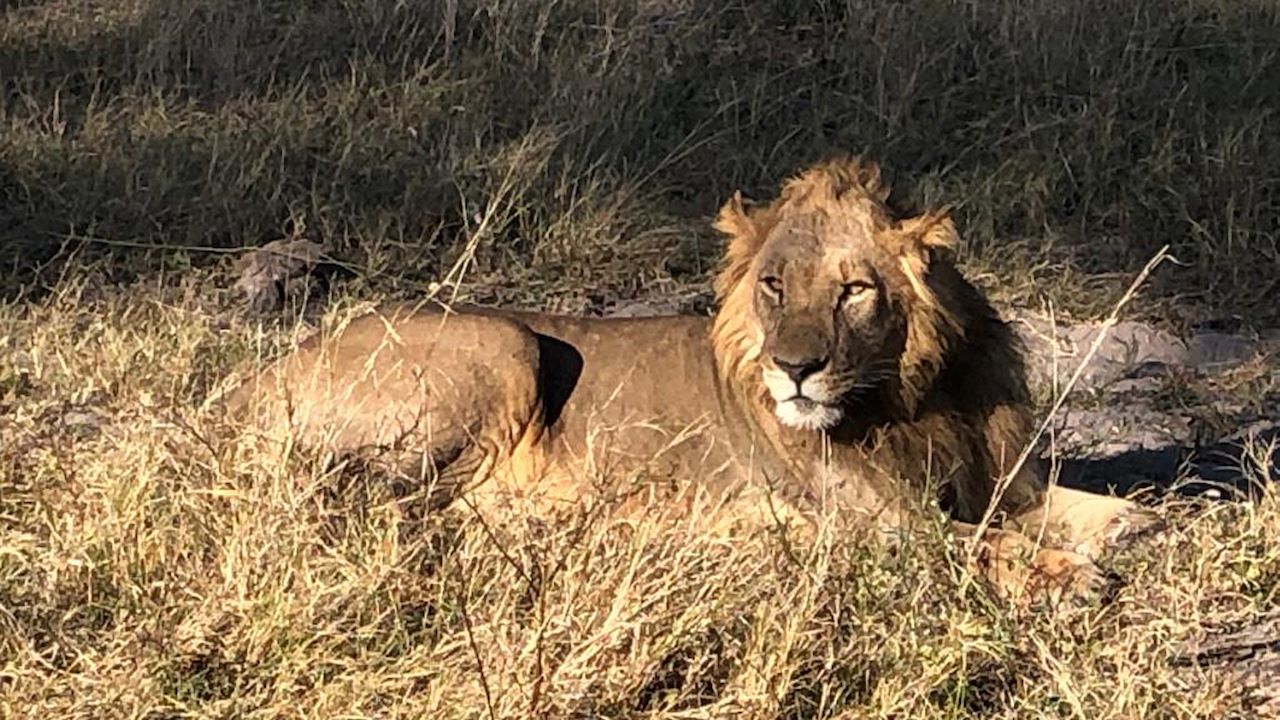
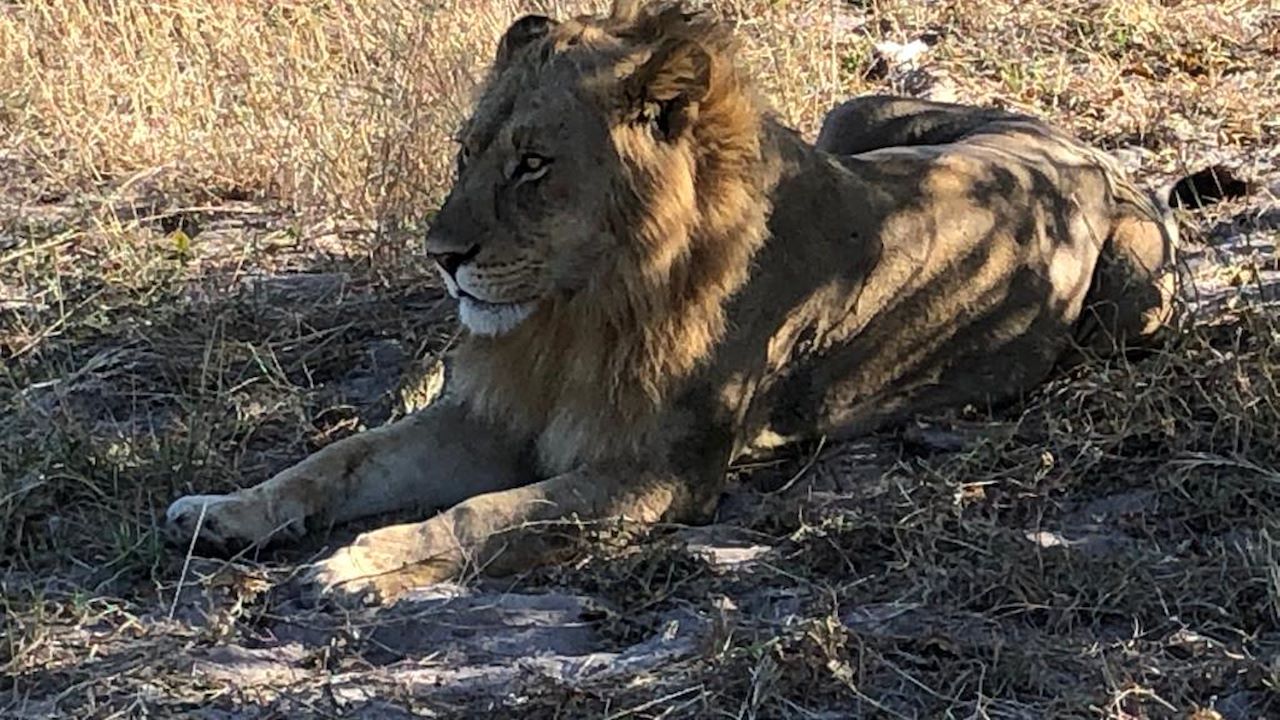


‘They made a kill some time ago, and those two big boys – the Eastern Boys – came and stole it from them. One of the young guys was badly injured…’
Muffled chat on the radio again; Jakes seems charged: ‘The Eastern Boys are on their way…’
We drive off to intercept them, heading into the midst of what seems like a lion showdown. Soon we spot the big Eastern Boy with the darker, fuller mane. He now has a major scar on the left side of his head, above his eye. He strides forward, stopping occasionally, listening.
We follow him back towards where the Northern Boys are lying, unsuspecting. I want to warn them – the Big Boys are coming! Obviously not done. We drive faster to join the other vehicles – five this time. Normally, just three are allowed at a sighting, but more for a special event like this. A turf war.

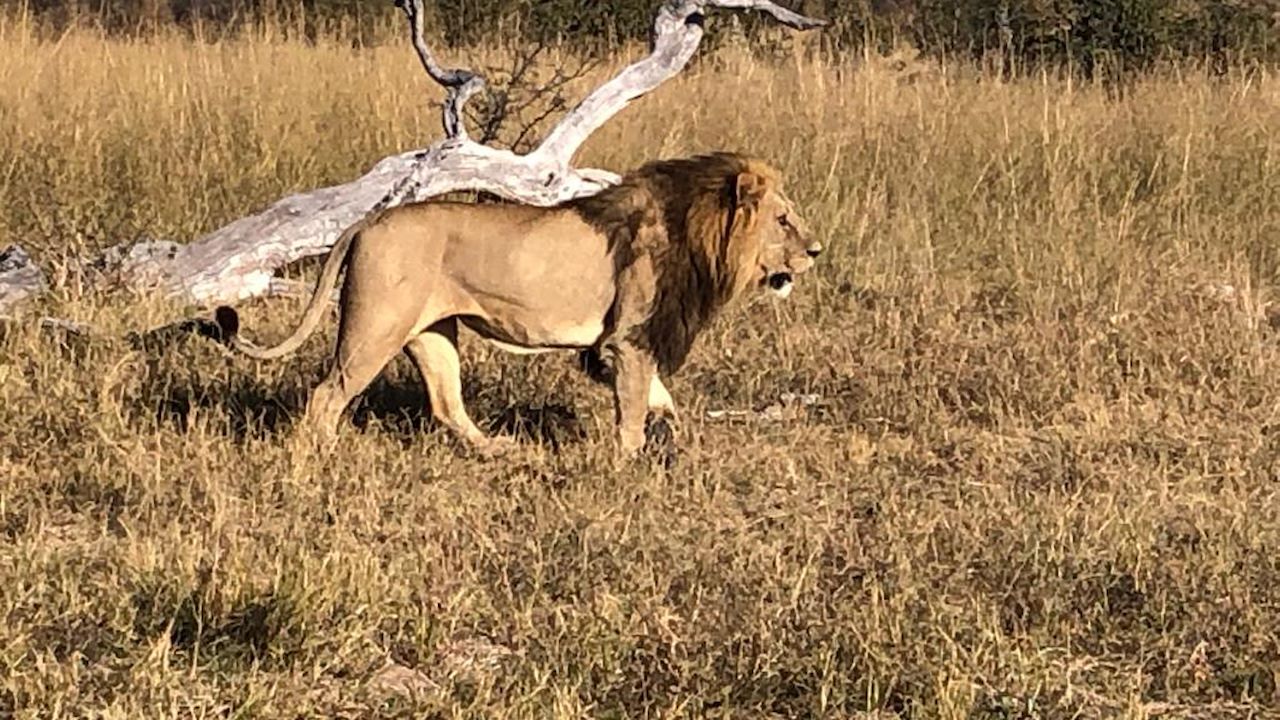
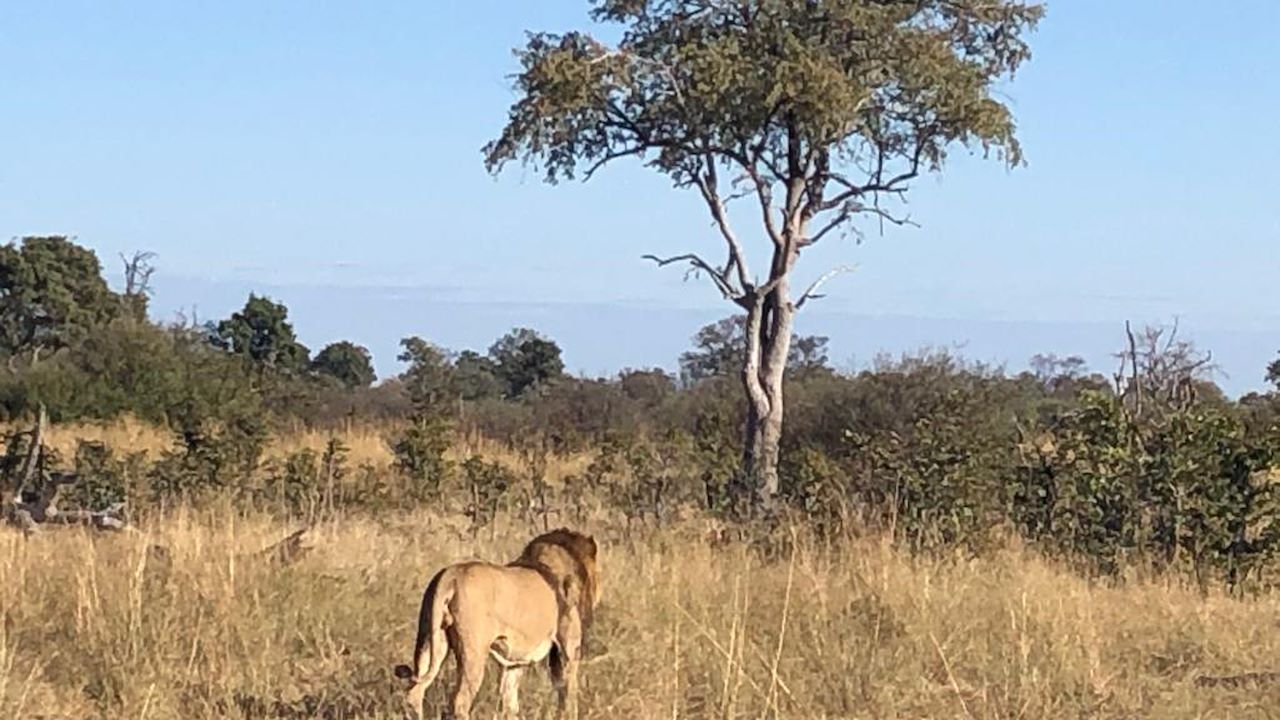


One of the Northern Boys gets up and limps into the sun.
‘Maybe he was injured by the big Eastern Boy’, Jakes says. ‘They found him mating a few weeks ago and they squashed him. Territorial disputes are a big problem with these lions’.
It gets ugly. ‘When lions fight, they target the back so they can break the spine. They generally fight to the death. Male lions kill each other every day’.
I’m not sure I want to witness what’s coming. Jakes says the big Eastern Boy is about 50 metres away now. ‘The Eastern Boys heard the younger ones calling this morning, and came silently to get them’.
To my delight, and others’ disappointment, the big Eastern Boys don’t show up. It’s time to head back to camp, anyway, and then to the airstrip. The cheeky Northern Boys live to hunt, mate, and fight another day.

On the way out, we pass the skull of the buffalo that the young Northern Boys killed about three weeks ago, later stolen by their elders. ‘They’ve had three to four fights so far’, Jakes says, ‘but the young ones don’t learn’.
Back at camp, my heart is sore at another separation. I quickly seek out Sasha and Nadia to say goodbye; hugs ensue, hopes of return.
The drive to the airstrip is too short, the goodbye to Jakes rushed. I’ll miss him.
As we fly over the Delta, I see elephants below, trailing across the sapphire waters. Tiny lush green islands seem empty, until we see a larger one and the sweeping tents of Mombo, Wilderness’ flagship. We briefly land. I envy the family getting off there.

We continue towards Maun, with the watery wilderness unfolding beneath us. I’d love to parachute down to one of the islands to see what I’d find there. Stay awhile. A week in Botswana is just the beginning. As much as I love home, love Cape Town – it’s just not wild enough.
Photographs by Melissa Siebert
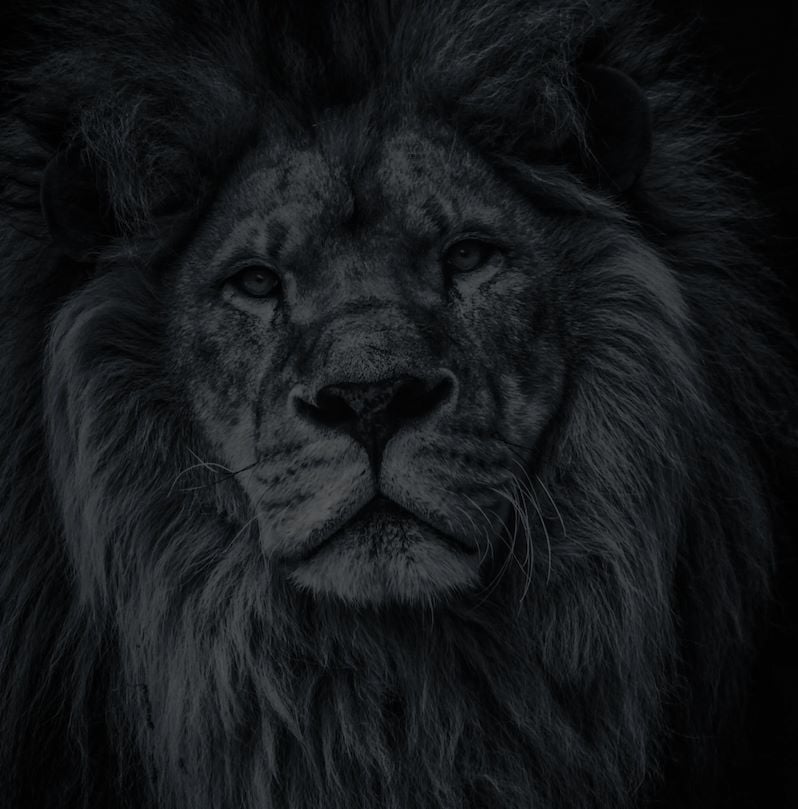
Let’s plan your next journey
Ready?
When we say we’re there every step of the way, we mean it, literally. From planning the perfect circuit, to private inter-camp transfers on Wilderness Air, and easing you through Customs. We’re with you on the ground, at your side, 24-7, from start to finish. Ready to take the road less travelled? Contact our Travel Designers to plan an unforgettable journey.